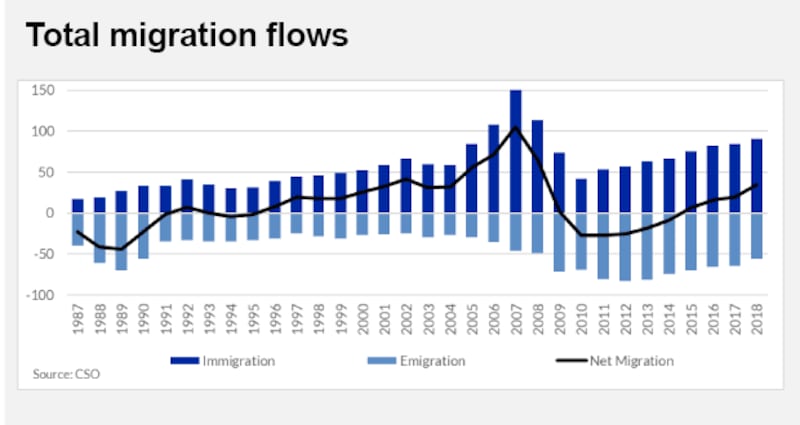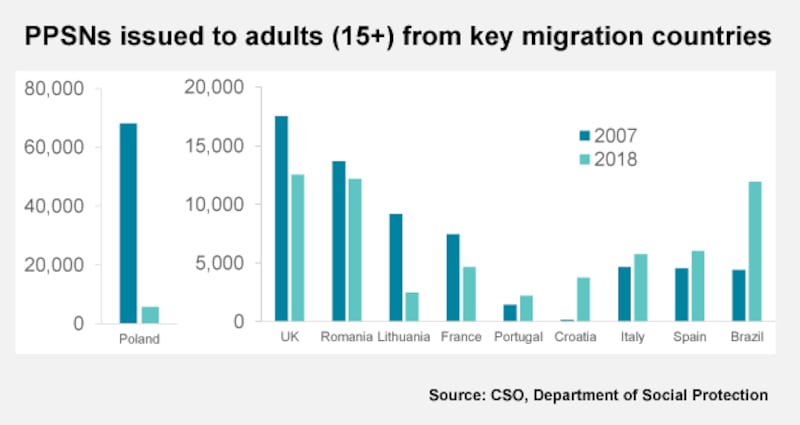The jobs boom has been the clearest evidence of the economic recovery, with the numbers at work now comfortably exceeding the peak of the previous boom in 2007. Migration has been a key factor both in recent economic upturns and downturns, with a massive inflow in the early 2000's – mainly from Eastern Europe – followed by a return to emigration during the crash. Now, new Central Bank research shows that the balance has swung again, with immigration exceeding emigration and new sectors very heavily reliant on employees from overseas. In turn, this has implications for areas such as housing – and for investment here in everything from public transport to health and education.
1. The key figures
During the bust, many people who had come to the State from Eastern Europe left the country, as did many Irish people. The numbers leaving exceeded the numbers arriving in 2009 – and this trend continued up to 2014. The net outflow of Irish nationals between 2008 and 2015 was 113,000 people. Now the trend has reversed. Recent research by the Central Bank* runs the numbers and estimates that net inward migration – the excess of people coming here over those leaving – averaged 23,000 a year since 2016. It is worth nothing that in 2007 we had a net migration inflow that exceeded 100,000.

Two trends explain this change. First, Irish people have stopped leaving. Or, more accurately, slightly more Irish people are now returning compared to those leaving. A paper by economists at the Central Bank and Department of Finance points to a "marginal net inflow of Irish nationals". Wages have been seen to be a key factor attracting people to return in the past – and no doubt this is now currently balanced against the high cost and lack of availability of housing.
The second trend is higher immigration from other countries, though the picture here is very different to what happened during the last boom. Then, there was a huge inflow from Eastern European and particularly from countries such as Poland and Lithuania who joined the EU in 2004. Now, the trend is different. The Eastern European jobs markets are much stronger than they were in the early 2000s and the wage gap with Ireland has shrunk.
As the Irish jobs market has approached full employment, more jobs are being filled by migrants.
The Central Bank/Department of Finance research looked at data on PPS numbers issued, which showed a rise in migrants from Southern European countries such as Spain and Italy, where youth unemployment is high, a big increase from Brazil and continued high levels of immigration from the UK and Romania. Croatia, which joined the EU in 2013, is a new, significant source of immigration, with a dramatic increase, albeit from a low base.
As the Irish jobs market has approached full employment, more jobs are being filled by migrants. The evidence shows that the vast majority of those arriving here are at work. The research paper calculates that since the third quarter of 2015, the average annual growth rate of employment among non-Irish nationals here has risen by 7 per cent, compared to 3 per cent for Irish nationals.

2. Key sectors relying on migrants
A breakdown of the figures shows the major reliance in some sectors on inward migration. Most notably, in 2018, almost half of the new hires in the ICT sector were migrants, 40 per cent of whom had arrived with the last year. In contrast, the construction sector hires almost entirely Irish employees. Around a third of the new jobs in accommodation and food and administration and support were filled by migrants last year, again the bulk of whom arrived here in the past 12 months.
Not surprisingly language-related jobs available in the Republic attract a high level of overseas interest
In a separate paper in the latest Central Bank quarterly bulletin, bank researchers look at up-to-date trends on what kinds of jobs people from outside the country are examining online, using data from the Indeed jobs website. This information was previously shown to have a close link with actual migration patterns. For all job postings on the Indeed site, around one-in-nine clicks (11 per cent) come from outside Ireland. This is well above the UK average of 3 per cent, though jobs in London attract a 9 per cent overseas share.
Not surprisingly language-related jobs available in the Republic attract a high level of overseas interest, with up to four in 10 of clicks on these jobs coming from jobseekers outside the country. These include jobs such as translators and bilingual sales representatives, key areas in many of the big digital companies here. Next most popular is technology, with one in three clicks on the Indeed site coming from outside Ireland, with around half of these coming from within the EU.
The final key insight from the Indeed data is the reliance of the health sectors on employees from outside the EU. A variety of jobs for doctors, nurses and healthcare employees attracted more than on in three of all clicks from outside the EU. Other specific jobs, such as senior civil engineers and senior software engineers, also rely heavily on interest from abroad.
3. The policy implications
Whether the Republic is at or close to “ full employment” is a matter of debate among economists and will have a vital influence on migration trends.
Where else might new employees come from, apart, of course, for the annual outflow from education?
The proportion of the population participating in the jobs market is lower than at the peak of the boom in 2007 – leading some economists to argue that there is still some slack. The Central Bank disagrees, arguing that the economy is now effectively at full employment. Back in 2007 a much higher proportion of the young male population was in the workforce, mainly in construction, it said. Now that age group is more likely to be in education.
Where else might new employees come from, apart, of course, for the annual outflow from education? Short-term unemployment is very low and most of those who left the jobs market during the crisis but could come back have now done so. Some 350,000 people in the 20 to 65 age group told the CSO they do not want a job, but the Central Bank questions how many of these might conceivably end up back in the workforce. And while female labour force participation is lower than that of males – and high childcare costs are a key barrier for some – the Central Bank points out that many more of this group are now at work than were a decade ago. It does not believe another big surge in female participation is likely.
This means migration will continue as a key source of employment.Central Bank researchers say it could also limit the overheating which can come in a very tight jobs market, and thus limit the growth in wages. In turn this can help the economy to remain competitive.
Inward migration will continue, the researchers believe, though is unlikely to return to its early-2000s peak.The big group of accession country migrants – which accounted for six in ten arriving between 2004 and 2007, only account for one in four of a much lower overall migrant total now.
Migrants “are increasingly highly skilled with the majority now holding at least tertiary qualifications”, the researchers say. Countries are now competing for the best international talent, seen as a key factor in driving growth.Ireland will be competing both for EU talent, the bank says, as well as non-EU employees, where the visa regime has been adjusted to address skills shortages, but may still prove a barrier to some. And in turn, with migration a key part of our economic future, providing proper housing, public transport and public services clearly becomes an even more vital part of economic policy.
* The Central Bank research used in this article is available in Box C of its quarterly bulletin number 2, 2019, published in April and in a number of signed articles in bulletin 3, published this week.
Smart Money is a weekly online column looking at the big economic trends and what they mean for you.












